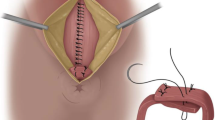Abstract
PURPOSE: This study was designed to critically analyze the outcome of sphincter repair and, if possible, to identify high-risk factors. METHODS: Clinical and physiologic assessment was made of all sphincter repairs (42 patients) performed in one unit by two surgeons during five years. RESULTS: Forty-two patients (10 men, 32 women) underwent sphincter repair. Only three of five men with anterior defects of the anorectum from perineal trauma were rendered continent. Only three of five men with defects from fistula operations became continent, but one improved by later graciloplasty. All six women with fistula-related injuries eventually achieved continence, but two required repeat sphincter repairs because of early breakdown from sepsis. The worst results were in 26 women with third-degree obstetric injuries, of whom 11 remain incontinent; poor results in this group were associated with gross perineal descent, obesity, and age older than 50 years; two or more of these factors indicated a poor outcome. Preoperative anorectal physiology did not identify a poor-risk group. CONCLUSIONS: Poor results were identified in women with anterior defects from obstetric trauma, especially if they were obese, older than 50 years of age, and had perineal descent.
Similar content being viewed by others
References
Hagihara PF, Griffen WO. Delayed correction of anal continence due to anal sphincter injury. Arch Surg 1976;111:63–6.
Slade MS, Goldberg SM, Schottler JL, Balcos EG, Christenson CE. Sphincteroplasty for acquired anal incontinence. Dis Colon Rectum 1977;20:33–5.
Castro AF, Pittman RE. Repair of the incontinent sphincter. Dis Colon Rectum 1978;21:183–7.
Sullivan ES, Corman ML, Devroede G, Rudd WW, Schuster MM. Anal incontinence (symposium). Dis Colon Rectum 1982;25:90–107.
Keighley MR, Fielding JW. Management of faecal incontinence and results of surgical treatment. Br J Surg 1983;70:463–8.
Browning GG, Motson RW. Anal sphincter injury: management and results of Parks sphincter repair. Ann Surg 1984;199:351–6.
Fang DT, Nivatvongs S, Vermeulen FD, Herman FN, Goldberg SM, Rothenberger DA. Overlapping sphincteroplasty for acquired anal incontinence. Dis Colon Rectum 1984;27:720–2.
Christiansen J, Pedersen IK. Traumatic anal incontinence: results of surgical repair. Dis Colon Rectum 1987;30:189–91.
Pezim ME, Spencer RJ, Stanhope CR, Beart RW Jr, Ready RL, Iltrup DM. Sphincter repair for fecal incontinence after obstetrical or iatrogenic injury. Dis Colon Rectum 1987;30:521–5.
Fleshman JW, Dreznik Z, Fry RD, Kodner IJ. Anal sphincter repair for obstetric injury: manometric evaluation of functional results. Dis Colon Rectum 1991;34: 1061–7.
Gledhill T, Waterfall WE. Postanal repair to restore fecal continence after failed sphincteroplasty. Can J Surg 1984;27:256–7.
Swash M, Snooks JJ, Henry MM. Unifying concept of pelvic floor disorders and incontinence. J R Soc Med 1985;78:906–11.
Deen KI, Kumar D, Williams JG, Grant EA, Keighley MR. Randomized trial of internal anal sphincter plication with pelvic floor repair for neuropathic fecal incontinence. Dis Colon Rectum 1995;38:14–8.
Laurberg S, Swash M, Henry M. Delayed external sphincter repair for obstetric tear. Br J Surg 1988;75:786–8.
Jacobs PP, Scheuer M, Juijpers JH, Vingerhoets MH. Obstetric fecal incontinence: role of pelvic floor denervation and results of delayed sphincter repair. Dis Colon Rectum 1990;33:494–7.
Yoshioka K, Keighley MR. Critical assessment of the quality of continence after postanal repair for faecal incontinence. Br J Surg 1989;76:1054–7.
Author information
Authors and Affiliations
Additional information
No reprints are available.
About this article
Cite this article
Nikiteas, N., Korsgen, S., Kumar, D. et al. Audit of sphincter repair. Dis Colon Rectum 39, 1164–1170 (1996). https://doi.org/10.1007/BF02081420
Issue Date:
DOI: https://doi.org/10.1007/BF02081420




